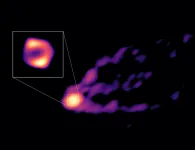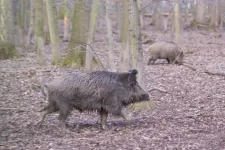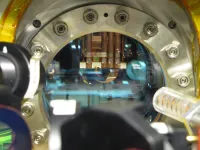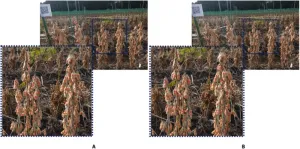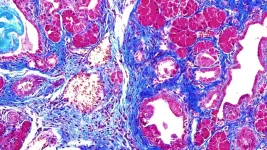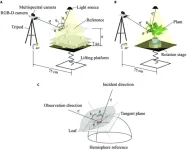(Press-News.org) Astronomers in the Canadian-led CHIME/FRB Collaboration have doubled the number of known repeating sources of mysterious flashes of radio waves, known as fast radio bursts (FRBs). Among them are astronomers from the University of Toronto. Through the discovery of 25 new repeating sources (for a total of 50), the team also solidified the idea that all FRBs may eventually repeat.
FRBs are considered one of the biggest mysteries in astronomy, but their exact origins are unknown. Astronomers do know that they come from far outside of our Milky Way, and are likely produced by the cinders left behind after stars die. Most of the thousands of FRBs that astronomers have discovered to date have only ever been seen to burst once, but there is a small subset that have been seen to burst multiple times. One of the big questions is whether the repeating FRBs and those that don’t repeat have similar origins. One key clue is that the two populations seem to have different characteristics, such as the durations of the bursts they produce, and the range of frequencies emitted. This has led to the consensus that there are possibly two distinct categories of FRBs: repeaters, and one-offs, with different origins.
Finding more repeating sources is key to answering this question and in new research published today in The Astrophysical Journal, the CHIME/FRB Collaboration presents 25 new sources. While they had previously established repeating FRBs as a class of sources, this is the first time they have combed through the data to find every repeating source detected so far, including the less obvious ones. To make this happen, the team developed a new set of statistics tools.
“We can now accurately calculate the probability that two or more bursts coming from similar locations are not just a coincidence,” explains Dr. Ziggy Pleunis, a Dunlap Postdoctoral Fellow at the Dunlap Institute for Astronomy and Astrophysics and corresponding author of the publication. “These new tools were essential for this study, and will also be very useful for similar research going forward.”
Thanks to radio telescopes like the Canadian Hydrogen Intensity Mapping Experiment (CHIME), the number of detected FRBs has grown from a few tens, to thousands in recent years. This is due to CHIME’s capacity to scan the entire northern sky every day. “That’s how CHIME has an edge over other telescopes, when it comes to discovering FRBs,” says Pleunis.
In their new research, the CHIME/FRB Collaboration has demonstrated that many repeating FRBs are surprisingly inactive, producing less than one burst per week of observing time.
"Many apparently one-off FRBs have simply not yet been observed long enough for a second burst from the source to be detected,” says Pleunis.
Repeating sources of FRBs are uniquely valuable to astronomers. First, knowing that a source is a repeater creates an opportunity to observe that same source with other telescopes in more detail. And second, more bursts give us more information on the diversity of emission that a source can produce.
"It is exciting that CHIME/FRB saw multiple flashes from the same locations, as this allows for the detailed investigation of their nature,” says Adaeze Ibik, a PhD student in the David A. Dunlap Department for Astronomy and Astrophysics at the University of Toronto, who has led the search for the galaxies in which some of the newly identified repeating FRBs are embedded, as reported in an accompanying research publication currently under review. “We were able to hone in on some of these repeating sources and have already identified likely associated galaxies for two of them.”
Pleunis notes that this new discovery brings us closer to understanding what FRBs are. While that is exciting in itself, he says there are even further-reaching implications.
“FRBs are likely produced by the leftovers from explosive stellar deaths.” Pleunis says. “By studying repeating FRB sources in detail, we can study the environments that these explosions occur in and understand better the end stages of a star's life.”
“We can also learn more about the material that's being expelled before and during the star’s demise, which is then returned to the galaxies that the FRBs live in.”
END
Astronomers double number of known repeating fast radio bursts
2023-04-26
ELSE PRESS RELEASES FROM THIS DATE:
First direct image of a black hole expelling a powerful jet
2023-04-26
For the first time, astronomers have observed, in the same image, the shadow of the black hole at the centre of the galaxy Messier 87 (M87) and the powerful jet expelled from it. The observations were done in 2018 with telescopes from the Global Millimetre VLBI Array (GMVA), the Atacama Large Millimeter/submillimeter Array (ALMA), of which ESO is a partner, and the Greenland Telescope (GLT). Thanks to this new image, astronomers can better understand how black holes can launch such energetic jets.
Most galaxies harbour a supermassive black hole at their centre. While black holes are known for ...
MD Anderson’s Hagop Kantarjian, M.D., awarded highest honor from American Society of Clinical Oncology
2023-04-26
The American Society of Clinical Oncology (ASCO) will present the 2023 David A. Karnofsky Memorial Award to Hagop Kantarjian, M.D., chair of Leukemia at The University of Texas MD Anderson Cancer Center, for his contributions to leukemia clinical research and his dedication to improving the lives of patients.
“Cancer research and patient care have been my life’s passion and mission and, I am honored to be recognized by ASCO with the society’s highest scientific award,” Kantarjian said. “I am grateful for all of the outstanding investigators in the Leukemia Department and outside ...
Bioindicator for the occurrence of PFAS
2023-04-26
The researchers focused on 66 PFAS compounds for their study. These can be grouped into three categories: 1) PFAS groups that have been regulated for some time; 2) new PFAS that industry uses as substitutes for regulated PFAS; and 3) precursors that can degrade to other, more persistent PFAS. However, because these individual analyses can detect only a small fraction of the more than 10,000 PFAS used by industry and because many polyfluorinated compounds cannot be measured because of the lack of analytical ...
Prolonged droughts likely spelled the end for Indus megacities
2023-04-26
New research involving Cambridge University has found evidence — locked into an ancient stalagmite from a cave in the Himalayas — of a series of severe and lengthy droughts which may have upturned the Bronze Age Indus Civilization.
The beginning of this arid period — starting at around 4,200 years ago and lasting for over two centuries — coincides with the reorganization of the metropolis-building Indus Civilization, which spanned present-day Pakistan and India.
The research ...
Advanced X-ray technique unveils fast solid-gas chemical reaction pathways
2023-04-26
For the rational design of new material compounds, it is important to understand the mechanisms underlying their synthesis. Analytical techniques such as nuclear magnetic resonance and spectroscopy are usually employed to study such mechanisms in molecular reactions. However, reaction pathways governing the formation of solid-state crystalline compounds remain poorly understood. This is partly due to the extreme temperatures and inhomogeneous reactions observed in solid-state compounds. Further, the presence of numerous atoms in solid crystalline compounds ...
Paradoxical quantum phenomenon measured for the first time
2023-04-26
Some things are related, others are not. Suppose you randomly select a person from a crowd who is significantly taller than the average. In that case, there is a good chance that they will also weigh more than the average. Statistically, one quantity also contains some information about the other.
Quantum physics allows for even stronger links between different quantities: different particles or parts of an extensive quantum system can "share" a certain amount of information. There are curious theoretical predictions about this: surprisingly, ...
Automated soybean seed counting: Ppgrading existing methods for improved accuracy
2023-04-26
Farming is one of the oldest activities in the world and has always been at the forefront of technological innovation. With mechanized equipment, modified seeds, and digital devices, every aspect of farming, from planting to harvesting is gradually getting optimized. These benefits have also translated to better crop yield estimation for crops such as soybean. Deep learning-based yield estimation models use approaches like regression, traditional bounding boxes, or density maps to make counting of seeds easier. Compared ...
Do fish bay at the moon? Can their odd songs identify Hawaiian mystery fish? Eavesdropping scientists progress in recording, understanding ocean soundscapes
2023-04-26
Using hydrophones to eavesdrop on a reef off the coast of Goa, India, researchers have helped advance a new low-cost way to monitor changes in the world’s murky marine environments.
Reporting their results in the Journal of the Acoustical Society of America (JASA), the scientists recorded the duration and timing of mating and feeding sounds – songs, croaks, trumpets and drums – of 21 of the world’s noise-making ocean species.
With artificial intelligence and other pioneering techniques to discern ...
This killer protein causes pancreatic cancer
2023-04-26
Pancreatic ductal adenocarcinoma (PDAC) is the most common form of pancreatic cancer. It’s also one of the deadliest. More than 90% of PDAC patients die within five years of diagnosis. Usually, by the time the cancer is identified, it has already spread.
“PDAC is often found too late for treatments like chemotherapy and surgery to be very effective,” Cold Spring Harbor Laboratory (CSHL) Professor Adrian Krainer says. “But if we can clearly understand the underlying genetic mechanisms of PDAC, this might lead to earlier diagnoses and new types of therapies.”
Krainer ...
Novel ‘registration’ method identifies plant traits in close-up photos
2023-04-26
Modern cameras and sensors, together with image processing algorithms and artificial intelligence (AI), are ushering in a new era of precision agriculture and plant breeding. In the near future, farmers and scientists will be able to quantify various plant traits by simply pointing special imaging devices at plants. However, some obstacles must be overcome before these visions become a reality. A major issue faced during image-sensing is the difficulty of combining data from the same plant gathered from multiple image sensors, also known as ‘multispectral’ or ‘multimodal’ ...
